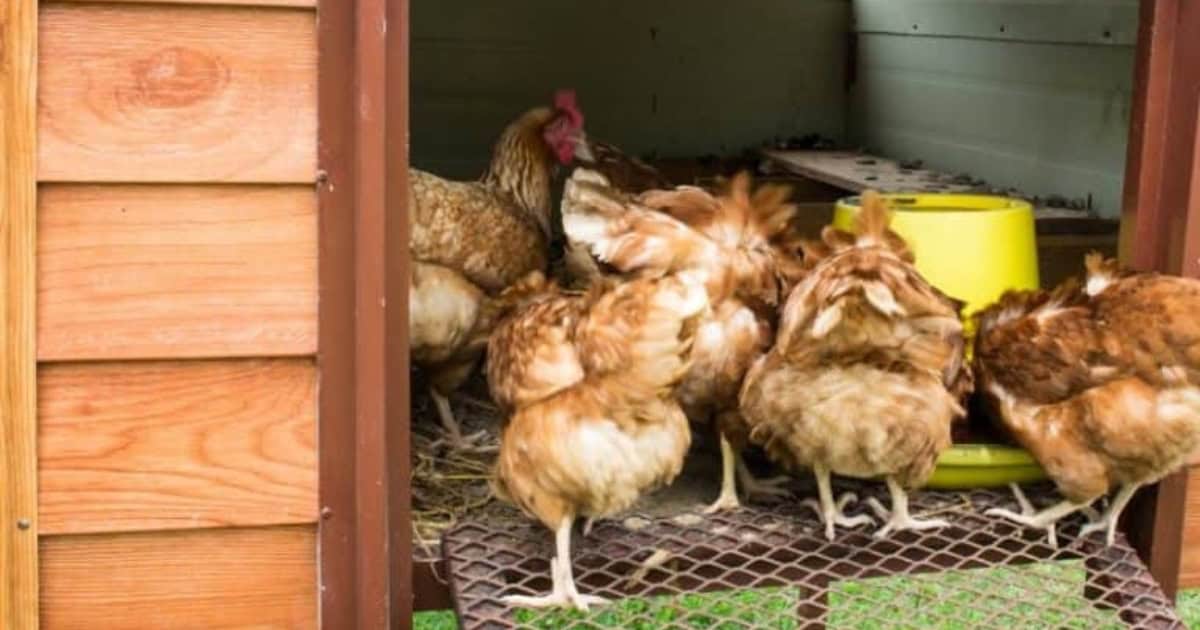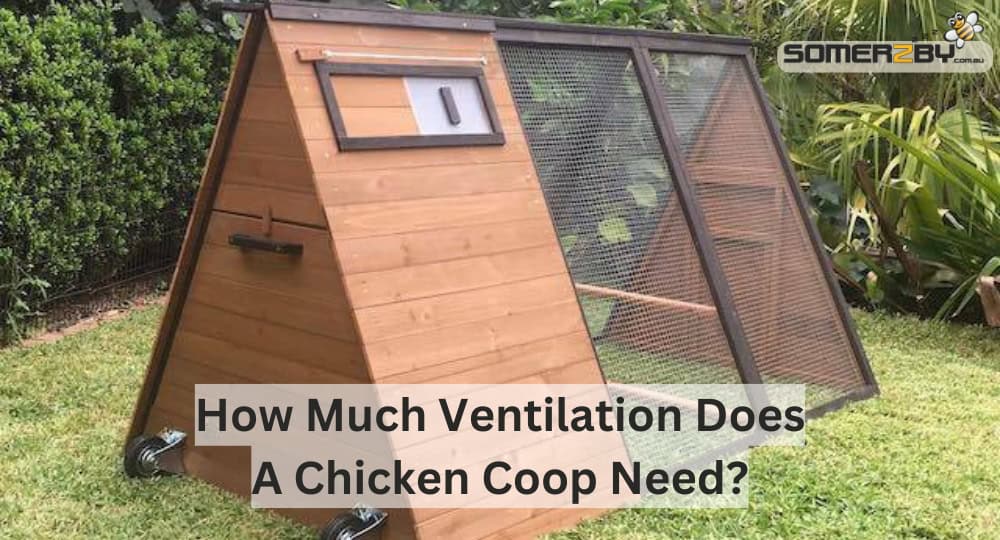Have you ever wondered just how much airflow your chickens need to stay healthy and happy? “How much ventilation does a chicken coop need?” is not just a question but an important part of poultry health.
In my own experience with backyard chickens, I’ve learnt that whether it’s battling the sweltering heat of the summer months or keeping things cosy during winter, it’s essential to understand just how much ventilation a chicken coop really needs.
Ensuring your birds receive an ample supply of fresh air can truly make the difference between a contented flock and an unhealthy one.
- Understanding the Importance of How Much Ventilation Does A Chicken Coop Need?
- Effects of Poor Ventilation on Chickens
- Factors Influencing Chicken Coop Ventilation Requirements
- Practical Steps to Ensure Adequate Chicken Coop Ventilation
- Recognising Signs of Inadequate Ventilation in Your Chicken Coop
- Toni’s Wrap
Understanding the Importance of How Much Ventilation Does A Chicken Coop Need?
Chickens produce a lot of moisture and ammonia. Every time they breathe and poop they’re adding to the humidity and gas levels in their coop.
If that stale air has nowhere to go, it will keep on building up creating a smelly and toxic environment for your feathered friends.
That’s where ventilation comes in. It allows fresh air to circulate, pushing out the bad and bringing in the good. This helps regulate temperature, humidity, and air quality in the coop.

Effects of Poor Ventilation on Chickens
So what happens when your chicken coop lacks proper ventilation?
Bad Odours: When ammonia and moisture accumulate inside chicken coops, they can generate some very unpleasant odours, creating an uncomfortable environment in the coop for both the chickens and chicken keepers.
Respiratory Issues: Ammonia buildup can cause some nasty respiratory issues in chickens, like coughing, wheezing, and even permanent lung damage. It can also lead to eye and skin irritation, making your chickens pretty miserable.
Moisture Accumulation: Excess moisture is another big issue. It can lead to mould, mildew, and fungal growth in the chicken coop, which can cause all sorts of health problems for your chickens. In cold weather that moisture can actually freeze on your chickens’ combs and wattles, causing frostbite.
Heat Stress: Inadequate ventilation setup can lead to high temperatures and high humidity levels, causing heat stress in chickens, which can result in decreased egg production, reduced feed intake, and even death in severe cases.
Behavioural Issues: Chickens may exhibit abnormal behaviours such as panting, wing spreading, and clustering in an attempt to cool themselves down in poorly ventilated environments. This can lead to increased stress levels and aggressive behaviour among flock members.

Factors Influencing Chicken Coop Ventilation Requirements
Size and Design of the Coop
First up: the size and layout of your coop. The bigger the coop, the more ventilation you’ll need to keep the air moving.
What counts is not the size of the ventilation openings but rather their efficiency. Larger openings may appear beneficial for ventilation, but their effectiveness relies on factors like placement, design, and management.
Efficient ventilation requires strategic placement of openings, proper ventilation systems suited to the coop’s size, and measures to prevent drafts and maintain consistent airflow.
If you have a tall, spacious coop with high ceilings, the warm, moist air will naturally rise up and out of any vents. But if you have a shorter, more compact coop, that air will linger around your chickens, so you’ll need more ventilation to compensate.
Number and Breed of Chickens
The more birds in your coop, the more moisture and ammonia they’ll produce, so you’ll need more ventilation to help keep things fresh.
Different chicken breeds have varying heat tolerance levels, with larger breeds and densely feathered breeds generating more body heat, potentially leading to increased coop temperatures.
Coops housing these breeds may require additional ventilation to prevent overheating discomfort. Breeds bred for cold climates may require less ventilation to maintain warmth.
Therefore, when designing or managing a chicken coop, careful consideration of the number and breed of chickens is crucial to ensure adequate ventilation and optimal living conditions for the flock.
Time Spent Free Ranging
The amount of time spent free-ranging directly impacts the ventilation requirements of a chicken coop. Chickens who spend most of their day free-ranging outside and less time confined within the coop contribute to less moisture, heat, and waste buildup.
As a result, ventilation needs may be lower compared to coops where chickens spend more time indoors.
However, even with free-ranging flocks, adequate ventilation remains essential to remove airborne contaminants and regulate internal conditions during time spent inside the shelter of the coop, such as at night or during bad weather.
Bedding Used
Materials like wood shavings, straw, or shredded paper absorb moisture effectively, reducing humidity levels and the need for excessive ventilation.
Certain bedding options also control ammonia by trapping it within the bedding, reducing the requirement for frequent air exchanges.
Chicken coop bedding with larger particles produces less dust, lessening respiratory irritation and minimising the need for extra ventilation.
Overall, selecting and managing coop bedding wisely can create a healthier environment for chickens, potentially reducing ventilation demands while ensuring optimal air quality and bird welfare.
Climate Considerations
Finally, your local climate will have a big impact on your coop’s ventilation needs.
In hot weather, you’ll want to create as much ventilation as possible with windows and vents to keep your coop cool and prevent overheating.
But in cold weather, it’s a bit trickier. You still need ventilation to prevent moisture buildup and ammonia, but you don’t want to create drafts that will chill your chickens.
If you live in a humid climate you’ll want more ventilation, as all that moisture in the air can lead to some serious coop issues if not properly managed.

Keeping your chicken coop well-ventilated is crucial, not just a luxury. It wards off respiratory issues, ammonia burns, and frostbite by managing humidity and air quality. Aim for 1/5 of your coop walls to be vents or windows, adjust based on the number of chickens and climate conditions to keep your feathered mates healthy.
Practical Steps to Ensure Adequate Chicken Coop Ventilation
Ventilating your chicken coop doesn’t have to be rocket science.
With just a couple of smart tweaks, you can ensure that fresh air is always circulating, keeping your chickens both happy and healthy.
Strategic Placement of Vents and Windows
First things first: location, location, location.
Positioning roosting bars below any windows or vents is crucial. Ensuring that the vents are placed high above your chickens’ heads allows warm, moist air to escape without directly blowing cold air onto them.
Cover those openings with hardware cloth or wire mesh to keep predators out while letting the air in.
And if you can, set up vents on opposite walls for cross-ventilation action.
Utilising Doors for Additional Airflow
Don’t underestimate the power of coop doors. If your coop has opening doors leading from the house area to the run, leaving these doors open during the day lets in a ton of fresh air.
Just make sure to close it up at night to keep your chickens safe from nighttime predators.
If you live in a cold climate, consider covering the doors with a heavy-duty tarp to create a curtain in the winter to prevent drafts while still allowing some airflow.
Choosing Suitable Bedding Materials
Not all bedding is created equal when it comes to moisture control. Pine shavings and hemp bedding are great at trapping moisture and reducing ammonia buildup in chicken coops.
Pine shavings quickly absorb moisture and neutralise ammonia odours, while hemp bedding’s absorbency and antimicrobial properties create a drier environment that inhibits ammonia buildup.
You can also consider using sand bedding, which dries out droppings quickly and makes coop cleaning a breeze.
Look for coops designed with pull-out trays or droppings boards below the roosting bars which help to catch the majority of the chicken poop, making it easier to maintain cleanliness and reduce the build-up of unpleasant odours.

Recognising Signs of Inadequate Ventilation in Your Chicken Coop
Even with the best intentions, sometimes our coops just don’t have enough airflow. Here’s how to spot the signs of poor ventilation before it becomes a big problem.
Detecting Moisture Issues
Excess moisture is a major red flag that your coop needs more ventilation. Look for condensation or mould on the coop walls or ceiling, damp bedding, or a general feeling of mugginess in the air.
If you spot any of these signs, it’s time to up your ventilation game. Add more vents, and open up windows and doors to get the air moving and the moisture out.
Identifying Respiratory Problems in Chickens
If you’re not careful with the airflow in your chicken coop, you might be causing a bunch of health problems for your feathered friends, especially when it comes to their breathing.
Watch for signs like wheezing, coughing, sneezing, or discharge from the eyes or nostrils. If you notice any of these symptoms, it could be a sign that the air quality in your coop is poor and needs improvement ASAP.
Adequate ventilation is key to preventing respiratory issues and keeping your chickens healthy. So if you spot these signs, don’t wait – take action to improve the airflow in your coop.
Your chickens will thank you with better health and more eggs.

Keep your chicken coop’s air fresh and flowing with strategic vent placement, suitable bedding, and by watching for signs of poor ventilation. Remember to adjust airflow with the seasons to keep your chickens healthy.
Toni’s Wrap
So there you have it – clear skies ahead in understanding how crucial proper airflow is inside those cosy coops.
It’s not about crafting an avant-garde dwelling with more windows than walls; rather, “how much ventilation does a chicken coop need” comes down to balancing act between too little and just right.
With smart vent placement and perhaps some strategic pop door usage, you’re setting up for success without inviting Old Man Winter or Summer Sun directly onto the roosts.
Remember, this isn’t Hollywood AI we’re talking about – where robots decide humanity’s fate – but something far simpler yet equally vital: giving our feathered companions what they need to thrive.




